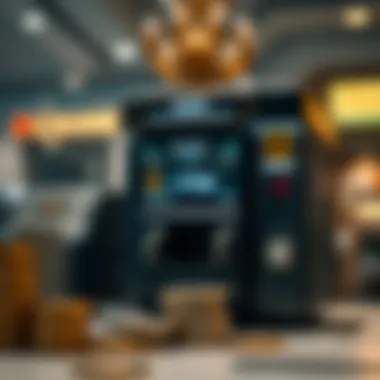Understanding Currency Conversion: 169 USD to AED


Intro
In today’s global economy, understanding currency conversion is more than just knowing the exchange rate. It is about recognizing the underlying factors that shape these rates. This article focuses on converting 169 US dollars (USD) to United Arab Emirates dirhams (AED), a task that goes beyond the simple arithmetic of multiplying or dividing by the current exchange rate.
The UAE, particularly Dubai, is a hotspot for international transactions, especially in the real estate sector. Therefore, comprehending the dynamics of currency conversion can significantly impact potential investments and lifestyle choices. As we delve into this topic, we will examine market trends, provide a buying and renting guide, and equip you with the knowledge to navigate the complexities of currency exchange effectively.
Understanding how much your money is worth when switching from USD to AED can save you a bundle when making big purchases. From appreciating the current economic landscape to future predictions, this guide aims to shed light on the many intricacies that come into play. Let's explore essential points that will lay a solid foundation for investors, buyers, agents, and analysts alike.
Foreword to Currency Conversion
Currency conversion involves exchanging one type of currency for another, an essential process in today’s interconnected economy. The importance of this topic lies in its relevance to various sectors, from international trade to tourism. When it comes to executing transactions—be it for personal or business purposes—understanding the conversion rates can significantly impact financial outcomes.
In the case of converting 169 US dollars (USD) into United Arab Emirates dirhams (AED), grasping the nuances of currency conversion becomes critical for numerous reasons.
Key Elements of Currency Conversion:
- Exchange Rate Determination: Understanding how exchange rates work provides insights into how much AED one can receive for USD. This fluctuates based on various economic conditions and market forces.
- Market Trends: Financial markets change rapidly; one moment the rate might seem advantageous, and moments later it can shift unfavorably. Staying updated on these trends is essential for making timely decisions.
- Costs and Fees: Via banks or services like Western Union, differing fees can apply when converting currencies. Knowing where to convert and which institution to use may save you considerable costs.
Benefits of Understanding Currency Conversion:
- Financial Awareness: Knowing how currency conversion works enhances an investor’s or buyer’s ability to conduct informed transactions, especially in markets like Dubai, known for vibrant real estate opportunities.
- Strategic Planning: For those planning investments or travel to the UAE, having a pulse on conversion factors can help budget more effectively. Understanding the conversion process better prepares one for the financial landscape ahead.
Considerations: While the world of currency conversion may seem straightforward on the surface, a multitude of variables can complicate matters. Factors such as political stability in regions, economic indicators, or even market sentiment play pivotal roles in influencing exchange rates. Therefore, a comprehensive understanding of these aspects is crucial to making savvy financial decisions.
"Currency conversion is not just a number, it’s the lifeblood of global transactions."
By grasping these elements of currency conversion, readers will be better equipped to navigate the complexities around converting 169 USD into AED, thus setting the tone for deeper dives into related topics like current exchange trends and practical implications in financial planning.
Current Exchange Rate Trends
When discussing the conversion of 169 USD to AED, it’s critical to grasp the current exchange rate trends. Understanding these trends helps investors and traders navigate the sometimes choppy waters of currency conversion, allowing them to make better decisions.
Recently, the USD to AED exchange rate has been fluctuating due to various factors that range from political events to economic reports. Such fluctuations can mean a difference of a few dirhams when transferring money or making investments in Dubai. This segment will dive into those fluctuations, explore the undercurrents of economy-focused indicators, and assess the influences of political landscapes and market sentiments on these rates.
Analysis of Recent Fluctuations
The fluctuations in the exchange rate are not just numbers; they reflect sentiments and realities of global economic shifts. In recent months, we have witnessed the UAE dirham maintain a relatively stable value against the US dollar, primarily due to the pegged currency system. However, occasional fluctuations occur. For instance, during economic downturns or financial crises, the USD might strengthen as it’s viewed as a safer asset. On the other hand, geopolitical tensions can cause the AED to dip as investors look for more stable options elsewhere.
Factors like trade balances, tourism influx, and even oil prices play a vital role in determining these exchange rate movements. As a result, understanding these trends equips one with the knowledge to anticipate market conditions better.
Factors Affecting Exchange Rates
Economic Indicators
Economic indicators, such as inflation rates, GDP growth, and employment statistics, are integral to understanding exchange rate behavior. In this context, economic indicators are key because they provide insights into a country’s economic health. When the US economy shows positive signs like increased job creation or robust industrial output, demand for the dollar typically rises, leading to appreciation against currencies like the AED.
What makes economic indicators particularly beneficial to this article is their ability to guide financial decisions. For example, a surge in USD due to favorable economic data may encourage investors to buy AED for future investments, anticipating higher costs later on. However, it’s also essential to note that relying solely on these indicators might mislead to rushed decisions without a broader context in place.
Political Stability
Political stability is another pivotal factor influencing currency conversion rates. A stable political environment fosters investor confidence, leading to a more favorable exchange rate. For the UAE, political stability boosts the AED’s strength, making it a sought-after currency. If, for instance, political unrest were to challenge this stability, the dirham might depreciate, negatively impacting those converting USD to AED.
The key characteristic here is trust. Trust in strong governance can cement investor confidence, positively affecting currency exchange rates. When this is lost, however, it can trigger a rapid response in the currency markets, leading to volatility. This makes political stability a crucial aspect of the conversation on USD to AED conversion, informing both short-term tactics and long-term strategies.
Market Sentiment


Market sentiment, or the general feeling of traders and investors regarding future market movements, plays a critical role in shaping currency exchanges. Often driven by news events, trends, and economic forecasts, market sentiment can sway the exchange rates rather quickly. For example, if traders believe the US economy will underperform, the demand for the dollar may weaken, thus affecting its value against the AED.
What gives market sentiments their unique weight is the psychological element. Even if economic indicators suggest stability, negative news can spur a loss of confidence among traders, causing the USD to dip against the AED. This makes it vital for anyone looking to convert currency to keep a finger on the pulse of not just economic indicators but also the broader feelings within financial markets.
Calculating USD to AED
Understanding how to convert 169 US dollars (USD) into United Arab Emirates dirhams (AED) not only helps in day-to-day transactions but serves as a fundamental aspect for anyone engaging with the financial landscape of the UAE. The conversion process itself is a concrete illustration of the shifting tides of global finance, encapsulating everything from economic health to anxiety over political stability.
The relevance of this conversion goes beyond mere numbers; it highlights significant economic indicators such as inflation rates and market confidence. Having a clear grasp on how to calculate conversions ensures individuals and businesses can make sound financial decisions, anticipate costs, and perhaps even forecast spending patterns when dealing in AED. This section delves into the calculations and methods behind translating the USD into AED.
Conversion Calculations
To perform the conversion from USD to AED, one typically multiplies the amount in dollars by the current exchange rate. Let’s say, hypothetically, the exchange rate sitting at 3.67 AED for 1 USD. The calculation therefore will be as follows:
[ 169 ext USD \times 3.67 ext AED/USD = 620.63 ext AED ]
This simple calculation gives one a straightforward estimate of what their USD holds in terms of AED, emphasizing how critical accurate rates are for effective financial planning. It’s essential to monitor these rates consistently as they can shift in the blink of an eye due to myriad factors.
Tools for Currency Conversion
Swiftly determining exchange rates is imperative in today’s fast-paced economy. Fortunately, various tools can assist individuals and traders in navigating the labyrinth of currency conversion.
Online Currency Converters
Online currency converters are typically regarded as the easiest and most convenient method for determining exchange rates. Websites like XE.com provide live updates, offering users real-time rates along with historical data trends. This feature is not just a luxury; it’s a necessity amidst fluctuating global markets. The user-friendly interface allows anyone, regardless of financial acumen, to easily plug in the amount they wish to convert, and within seconds, accurate figures materialize.
The unique benefit of online currency converters lies in their accessibility, allowing round-the-clock conversion capabilities. However, these platforms might not always consider transaction fees or service charges, which can arise during actual exchanges. Therefore, while they are a popular choice for quick conversions, users should also be cautious about relying solely on them for budgeting large transactions.
Mobile Applications
In the age of smartphones, mobile applications offer another layer of convenience for currency conversion. Apps like Currency Converter Plus are designed to deliver immediate calculations at one’s fingertips, syncing with up-to-date exchange rates. This portable accessibility means investors or travelers can make informed decisions on the fly, without needing to search through websites.
A key characteristic of mobile applications is their offline functionality — which allows users to access past rates without needing an internet connection. On the downside, certain apps might lack comprehensive features available on websites, potentially limiting in-depth analysis. Understanding these nuances ensures users can maximize the tools at hand effectively.
The right tools for currency conversion can empower you to make informed financial decisions, avoiding pitfalls that could lead to unnecessary losses.
Historical Context of USD to AED Exchange Rates
Understanding the historical context of USD to AED exchange rates is crucial for anyone engaged in financial endeavors involving currencies, especially for investors and real estate buyers in Dubai. This section provides a backdrop against which current and future trends can be evaluated, offering insights that will enable better financial decision-making. Knowing how previous events shaped today's rates can help stakeholders anticipate future movements, thus making informed choices when exchanging currencies or investing in properties in the UAE.
Trends Over the Last Decade
Over the past ten years, the exchange rate of USD to AED has demonstrated a relatively stable pattern, primarily due to the UAE's fixed exchange rate system, which ties the dirham closely to the dollar. The long-standing peg of 3.67 AED to one USD has provided a sense of security for businesses and investors. However, fluctuations still occur within a narrow band. For instance, during 2015–2016, as oil prices plummeted, there were discussions about the peg's sustainability due to implications on the broader economy. On the flip side, since 2017, there's been a gradual strengthening of the dollar due to consistent economic growth in the USA, affecting investor outlook towards currencies globally.
- Yearly Exchange Rates Insights:
- 2014–2016: Volatility due to falling oil prices.
- 2017–2019: Stability returned with oil prices recovering.
- 2020: Pandemic impacts causing worldwide currency shifts.
- 2021 onwards: Gradual strengthening of USD affecting exchange perceptions.
Evaluating these trends assists investors in understanding when to enter or exit currency exchange in relation to the real estate market. A comprehensive look at these trends provides insights that allow stakeholders to pinpoint windows of opportunity.
Impact of Global Financial Events
The USD to AED exchange rate does not operate in isolation as it is influenced by broader financial events. Economic downturns, geopolitical tensions, and market trends can create ripples that affect the value of both currencies. For example, the 2008 financial crisis led to a significant global downturn, and although the UAE was not as heavily affected as other nations, it still felt the repercussions through decreased foreign investment and tourism.
Similarly, the ongoing tensions in the Gulf region have an impact on investor confidence. Any rumor of instability can shake the financial markets. With the 2020 pandemic, the world witnessed an unprecedented situation. As the USD, traditionally a safe haven currency, rallied, the AED remained steady due to its peg, showcasing resilience amidst global chaos.


- Key Events to Consider:
- The 2008 Financial Crisis: Led to decreased investment and changes in investor behavior.
- Geopolitical Tensions: Predictable shifts in the exchange rates based on news and events.
- COVID-19 Pandemic: Unforeseen volatility influenced numerous currencies but ADA managed to stay stable.
"Historical data reveals that understanding the past helps not only in forecasting but also in making informed decisions that benefit future investments."
These examples underline that a deep acquaintance with historical context further equips investors, buyers, and analysts engaging with the Dubai market, making them well-prepared for potential fluctuations in currency values.
Practical Implications for Real Estate Transactions
When diving into real estate in Dubai, understanding the currency conversion between USD and AED becomes crucial. This knowledge isn't just some nice-to-have; it carries real, tangible implications for individuals and businesses looking to make their mark in this thriving market. Fluctuations in exchange rates can impact everything from purchase prices to returns on investment, making it a vital area to wrap your head around.
Understanding Costs in AED
Real estate transactions are often discussed in AED, but for those coming from a USD background, this can present a puzzling challenge. Let’s break this down.
Imagine you’re eyeing a luxurious apartment overlooking the Burj Khalifa, listed at 600,000 AED. With an exchange rate hovering around 3.67 AED to 1 USD, converting that price into dollars shows that you’re looking at approximately 163,000 USD. Understanding these numbers helps potential buyers assess overall affordability better and makes budgeting a less murky endeavor.
- Transaction Fees: Don’t forget about transaction fees, which may also vary based on the currency used. Banks and money exchange services often charge different fees depending on whether you are converting AED to USD or vice versa.
- Legal Costs: These too can fluctuate with the exchange rates, impacting your budget significantly if not planned for appropriately.
Investment Strategies in Dubai
Investing in Dubai real estate can be a goldmine, but it isn’t without its pitfalls. Understanding the currency implications can steer your investment decisions in a more favorable direction.
Buying Property
When it comes to buying property in Dubai, one distinct advantage is the lack of property tax, making it a friendly environment for foreign investments. Now, if you’re converting funds from USD to AED, the timing of your transaction can significantly impact your overall cost.
- Key Characteristic: One notable feature about purchasing property in Dubai is that the market often remains buoyant even amid global economic fluctuations. This characteristic makes buying property an attractive option for long-term gains, as well as providing an occasional cash flow in the form of rent.
- Advantages and Disadvantages: However, keep in mind that the market can be unpredictable. A sudden shift in exchange rates could mean you end up paying more AED than originally expected if you’re transferring large sums.
Renting Considerations
Renting in Dubai can be another appealing option. Not just for those looking to live there short-term, but also for investors trying to maximize returns on rental yield.
- Key Characteristic: Renting tends to offer flexibility, which can serve well in a volatile market. As economic conditions change, so does the ability to either renew a lease at a lower rate or switch to a different property.
- Unique Features: That said, it’s essential to note how the rent is often quoted in AED, and you must stay alert to conversion rates because they directly affect your monthly budget.
"Navigating currency conversion complexities may seem daunting, but with proper knowledge and tools, it can enhance your investment strategy in a rapidly growing market like Dubai."
In summary, understanding the financial landscape around buying or renting property in Dubai, given the currency conversion between USD to AED, is not merely academic. It is practical, and can yield significant financial benefits if approached wisely.
The Role of Financial Institutions
Financial institutions play a pivotal role in the world of currency conversion, particularly when it comes to understanding the exchange from USD to AED. They are the arteries through which money flows in the economy, providing essential services that facilitate transactions, investments, and financial planning. For anyone involved in real estate transactions in Dubai, knowing how these institutions operate is crucial in navigating the ever-changing financial landscape.
Bank Services and Currency Exchange
Banks offer a variety of services that are integral when converting currencies. When exchanging 169 USD to AED, one must be acquainted with how banks can make or break the experience.
Key services include:
- Currency Exchange: Most banks offer foreign exchange services, allowing customers to convert USD to AED at competitive rates. This can often be done at physical branches or through online banking platforms.
- Wire Transfers: If a buyer is looking to purchase property, banks facilitate wire transfers to ensure funds are seamlessly transferred, often cutting down wait times significantly compared to non-institutional methods.
- Expert Consultation: For those unsure about timing their conversion or understanding the nuances of currency movements, many banks provide advisory services, helping clients make informed decisions.
While banks are generally reliable, their fees can vary. Interaction with a bank can sometimes feel like solving a puzzle without the complete picture; hidden fees or unfavorable rates may sneak in, leaving individuals scratching their heads over the final amounts. It’s crucial to read the fine print before completing any transactions.
Evaluating Exchange Rate Margins


Exchange rate margins refer to the difference between the buying and selling rates of a currency pair, in this case, USD and AED. Understanding these margins can save several dirhams, especially when larger sums are involved.
When assessing banks, consider the following:
- Bid-Ask Spread: The rate at which your bank buys AED in return for USD (the bid) can be significantly lower than the rate at which they sell USD in exchange for AED (the ask). This margin is where banks make a profit, and it’s crucial for anyone looking to exchange currencies to be aware of this difference.
- Comparison Shopping: Don’t just settle for the first rate you come across. Use online resources or financial calculators to compare rates across a range of banks. Often, there are promotional rates or special offerings at certain financial institutions, which can provide advantageous margins.
- Market Movements: Exchange rates aren’t set in stone. They fluctuate based on various factors such as economic indicators and geopolitical stability. Financial institutions that monitor these movements closely can provide insights into when to convert USD to AED for better rates.
In summary, understanding the role of financial institutions in currency conversion is crucial for making informed decisions in financial transactions. Banks not only provide necessary services for currency exchange but also shape the overall experience through their fee structures and services. Investors and buyers should empower themselves with knowledge to navigate these institutions effectively, ensuring they get the best value for their currency.
Future Outlook for USD to AED Conversion
As we peer into the crystal ball of currency exchange, the USD to AED conversion offers a fascinating landscape that evolves with the tides of global economics. For investors, buyers, and market analysts alike, having a solid grasp of potential changes in this conversion rate can be pivotal. Knowing what the future might hold allows proactive decision-making and better financial planning, especially when dealing in an ever-shifting marketplace.
Predicting Exchange Rate Movements
Predicting how the exchange rate between the US dollar and the UAE dirham is likely to shift might seem like trying to read tea leaves. However, it’s not all guesswork. There are some indicators and patterns that can help financial minds chart the waters ahead.
One key player in this prediction game is the U.S. Federal Reserve. The interest rates set by the Fed can create ripples across the globe. When they raise rates, for instance, the dollar often strengthens. This might suggest, for a time, that converting USD to AED will become more favourable. Conversely, if rates decrease, the dollar could weaken against the dirham, meaning one might get fewer AED for their dollars.
Another element to consider is geopolitical stability. Any turmoil or uncertainty can prompt investors to scour for safer assets. The UAE, enjoying relative calmness, could attract influx which supports the dirham. As such, a rise in demand for AED can lead to notable fluctuations in its value against the dollar.
In short, here are the primary elements to gauge for predicting movements:
- Central bank decisions
- Inflation rates in the U.S. and UAE
- Political events affecting regional stability
- Economic growth comparisons between the U.S. and UAE
By keeping a close watch on these indicators, stakeholders can develop a clearer picture of potential exchange rate movements.
Potential Economic Shifts
In addition to predicting exchange rate movements, it is crucial to understand the broader economic shifts that could affect the USD to AED exchange rate. The world economy is interconnected, and changes in one area can have surprising ramifications in another.
Consider, for example, the current trends towards sustainable practices and green economics. As the UAE invests in renewable energy – such as solar and wind – this shift could greatly enhance their economic footprint. An economy progressively leaning on sustainable practices not only attracts foreign investment but can also lead to a stronger AED if market confidence grows.
Also, fluctuations in oil prices can alter the balance. The UAE is a significant oil exporter. If crude oil prices surge, the resultant financial influx might bolster the dirham's value. On the flip side, a decline in oil prices can jeopardize the UAE's economy, potentially leading to a weaker AED against the dollar.
Further, upcoming trade agreements and geopolitical alliances could redefine economic interactions. As economies seek new partnerships to bolster growth, the impact on currency value could be profound.
To summarize, here are the factors in the realm of economic shifts:
- Shifts towards sustainability and innovation in the UAE.
- The impact of oil prices on the UAE economy.
- New trade partnerships reshaping economic dynamics.
None of these factors stands isolated, and their interplay can lead to increased volatility in the USD to AED exchange landscape.
Staying informed on the economic climate can arm investors with the strategic knowledge necessary to navigate currency fluctuations and make prudent financial decisions.
Epilogue
In analyzing the journey of converting 169 US dollars (USD) to UAE dirhams (AED), it becomes clear that understanding currency conversion is more than just a calculation of numbers; it’s a pivotal aspect of cross-border financial interactions that affects a wide array of stakeholders. This article has unpacked various dimensions of currency conversion, including nuances of exchange rate movements, potential influences of economic data, and practical implications for real estate transactions. The understanding of these facets is crucial, particularly for investors, buyers, agents, and analysts operating in markets like Dubai.
Recap of Key Points
- Definition and Significance: The article opened with the definition of currency conversion and emphasized its critical role in facilitating global trade.
- Current Trends: An exploration of the recent fluctuations in exchange rates showcased how dynamic conditions in the economic environment can cause shifts in currency value.
- Historical Context: The discussion on historical trends provided insights on how past events influence current rates, giving a perspective that can aid future decision-making.
- Practical Real Estate Insights: For investors looking to navigate the real estate landscape, it highlighted the key parameters on understanding costs in AED, as well as strategic avenues for investment in Dubai.
- Financial Institutions' Role: Evaluating the services offered by banks and the margins in exchange rates underlined their significance in conducting transactions efficiently.
- Future Predictions: Insightful predictions on currency movements equip stakeholders with knowledge on potential economic shifts that could affect investments.
Final Thoughts on Financial Decision-Making
As we wrap up, it's vital to remind ourselves that engaging in currency conversion necessitates a balance of analytical skills and market intuition. The financial landscape is forever evolving, influenced by myriad factors as discussed throughout this article. Investors and buyers are urged to approach their decisions with careful consideration of the reading presented here.
In essence, whether one is merely exchanging money for travel or investing substantial sums in property, understanding these principles equips them to navigate through financial landscapes with more confidence. With a proper grasp of conversion impacts on budget allocations, individuals can unlock their potential for better returns and smarter investments.
"In the world of finance, knowledge isn't just power; it's your currency."
As the dynamic between USD and AED evolves, keeping abreast of changes is not just informative—it should be imperative. It’s this understanding that can make the difference between a sound investment and a misstep in a rapidly changing market.















